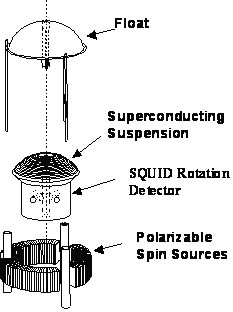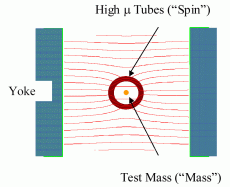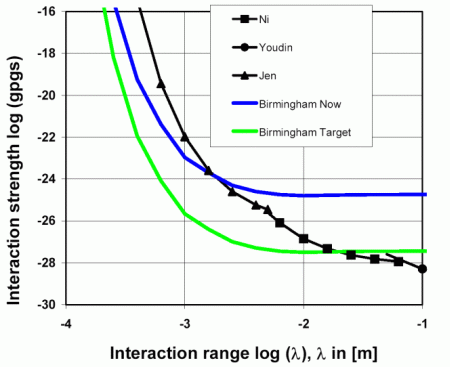Mass Spin .
Time reversal spin coupling
Contact C. C. Speake
In this experiment we aim to search for, and discover or place new limits on, the
strength and range of a new interaction that couples mass and spin. Such an
interaction would be expected to be mediated by the axion, the U-boson or the
schizon and would violate time reversal symmetry and parity.
Because any such interaction is expected to be very weak (otherwise it would have been found already), it is necessary to create a large amount of aligned spins (in our case we use of the order of 1020) and to search for a coherent interaction between these spins and around 1021 unpolarised fermions.
The sources of quantum mechanical spin have being manufactured at Imperial College in collaboration with G.K.Rochester and T.J.Sumner and have a novel null-type design. The spin signal is provided by the polarisation of high permeability tubes that surround the test masses, which are in turn suspended from our superconducting spherical torsion balance. The polarisation is induced and modulated by a toroidal electromagnet. The net magnetic field within the tubes is nominally zero. However, because the axion-like interaction is short range, the magnetic field generated by the local electronic spins in the tube can carry with it a spin-coupling field that is not cancelled by the more remote electromagnet. Figure 1 shows a schematic of the overall experimental set-up, and figure 2 shows a close-up of the interaction region, with magnetic field lines from the electromagnet shown. For clarity, the superconducting shield on the inside of the high permeability tubes is not shown.

[Figure 1. Overall experimental set-up ]

[Figure 2. Interaction Region ]
The basic experimental procedure consists of modulating the polarisation of the spins at a given frequency, and searching for a torque on the torsion balance at that same frequency.
Two main systematic background effects, both of magnetic origin, might mimick a new interaction:
1) A permanent dipole moment on one of the test masses, say due to impurities in the material, could interact with a modulated residual magnetic field gradient (see figure 3). This would result in a magnetic force indistinguishable from a force coupling to intrinsic spin. The only way to deal with this problem is to obtain independent measurements of the residual dipole moments and field gradients, and we have carried out dedicated experiments for this purpose.


[Figure 3. A permanent moment coupling to residual field gradients results in a magnetic torque]
2) If the magnetic shielding is insufficient, the magnetic field from the electromagnet could find its way into the torsion balance rotation detector, and interact with the torsion balance directly (see figure 4). Through various mechanisms, this can lead to magnetic torques at the signal frequency. The only solution to this problem is to improve the magnetic shielding to the required level.

[Figure 4. Direct magnetic coupling between Spin Source field and torsion balance results in a magnetic torque]
We have recently completed our first series of experiments, and find that we are limited, at present, by our ability to shield the spin source circuit from the torsion balance. Nevertheless, the results obtained so far are of sufficient quality for us to set constraints on the existence of a mass-spin coupling force that exceed previous ones for ranges shorter than a few mm.
Figure 5 shows existing limits to spin-coupling forces, together with our recent results (labeled “Birmingham Now”). At a range of 1mm, we improve existing limits by about one order of magnitude.
We are currently working on an experiment with improved shielding. Assuming that we can solve the shielding problem, we will be limited by the statistical noise in our instrument. Nevertheless, this should allow us to increase our sensitivity to the curve labeled “Birmingham Target”.

[Figure 5. Existing limits on spin-coupling forces (black), limits set by our experiment at
present (blue) and our target sensitivity in the short to medium term (green)]